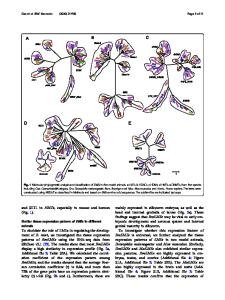Epigenetic modification mechanisms involved in keloid: current status and prospect
- PDF / 3,664,783 Bytes
- 19 Pages / 595.276 x 790.866 pts Page_size
- 44 Downloads / 383 Views
Open Access
REVIEW
Epigenetic modification mechanisms involved in keloid: current status and prospect Wenchang Lv†, Yuping Ren†, Kai Hou†, Weijie Hu, Yi Yi, Mingchen Xiong, Min Wu*, Yiping Wu* and Qi Zhang*
Abstract Keloid, a common dermal fibroproliferative disorder, is benign skin tumors characterized by the aggressive fibroblasts proliferation and excessive accumulation of extracellular matrix. However, common therapeutic approaches of keloid have limited effectiveness, emphasizing the momentousness of developing innovative mechanisms and therapeutic strategies. Epigenetics, representing the potential link of complex interactions between genetics and external risk factors, is currently under intense scrutiny. Accumulating evidence has demonstrated that multiple diverse and reversible epigenetic modifications, represented by DNA methylation, histone modification, and non-coding RNAs (ncRNAs), play a critical role in gene regulation and downstream fibroblastic function in keloid. Importantly, abnormal epigenetic modification manipulates multiple behaviors of keloid-derived fibroblasts, which served as the main cellular components in keloid skin tissue, including proliferation, migration, apoptosis, and differentiation. Here, we have reviewed and summarized the present available clinical and experimental studies to deeply investigate the expression profiles and clarify the mechanisms of epigenetic modification in the progression of keloid, mainly including DNA methylation, histone modification, and ncRNAs (miRNA, lncRNA, and circRNA). Besides, we also provide the challenges and future perspectives associated with epigenetics modification in keloid. Deciphering the complicated epigenetic modification in keloid is hopeful to bring novel insights into the pathogenesis etiology and diagnostic/therapeutic targets in keloid, laying a foundation for optimal keloid ending. Keywords: Keloid, Epigenetic modification, DNA methylation, Histone modification, ncRNAs Introduction Keloid is a common dermal fibroproliferative disorder characterized by the aggressive proliferation of fibroblasts and the excessive accumulation of ECM, like collagen [1]. Keloid is more likely to occur in areas of the body where the skin is tight and repeatedly stretched, namely the front chest, shoulder deltoid, abdomen, and ear. The characteristic growth pattern of keloid is closely associated with the magnitude of skin tension and the direction *Correspondence: [email protected]; [email protected]; [email protected] † Wenchang Lv, Yuping Ren, and Kai Hou are co-first authors and have the same contribution to this manuscript Department of Plastic and Aesthetic Surgery, NO 1095 Jiefang Avenue, Tongji Hospital, Tongji Medical College, Huazhong University of Science and Technology (HUST), Wuhan 430000, Hubei, China
of mechanical strain. On account of continuing to grow and expanding without spontaneous resolution, patients are usually accompanied by itching and pain, especially keloid contractures located near the joints may lead to serious
Data Loading...











